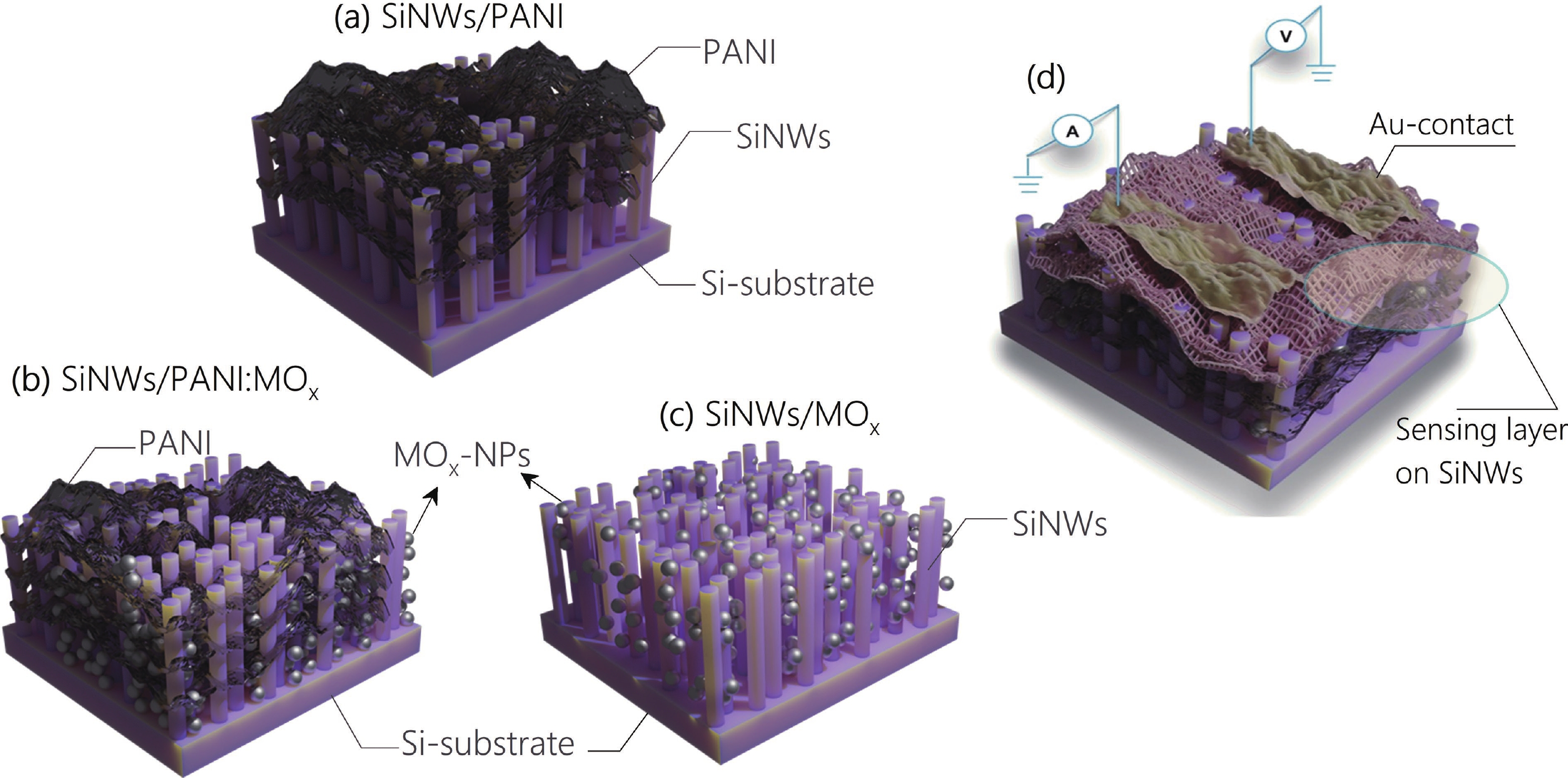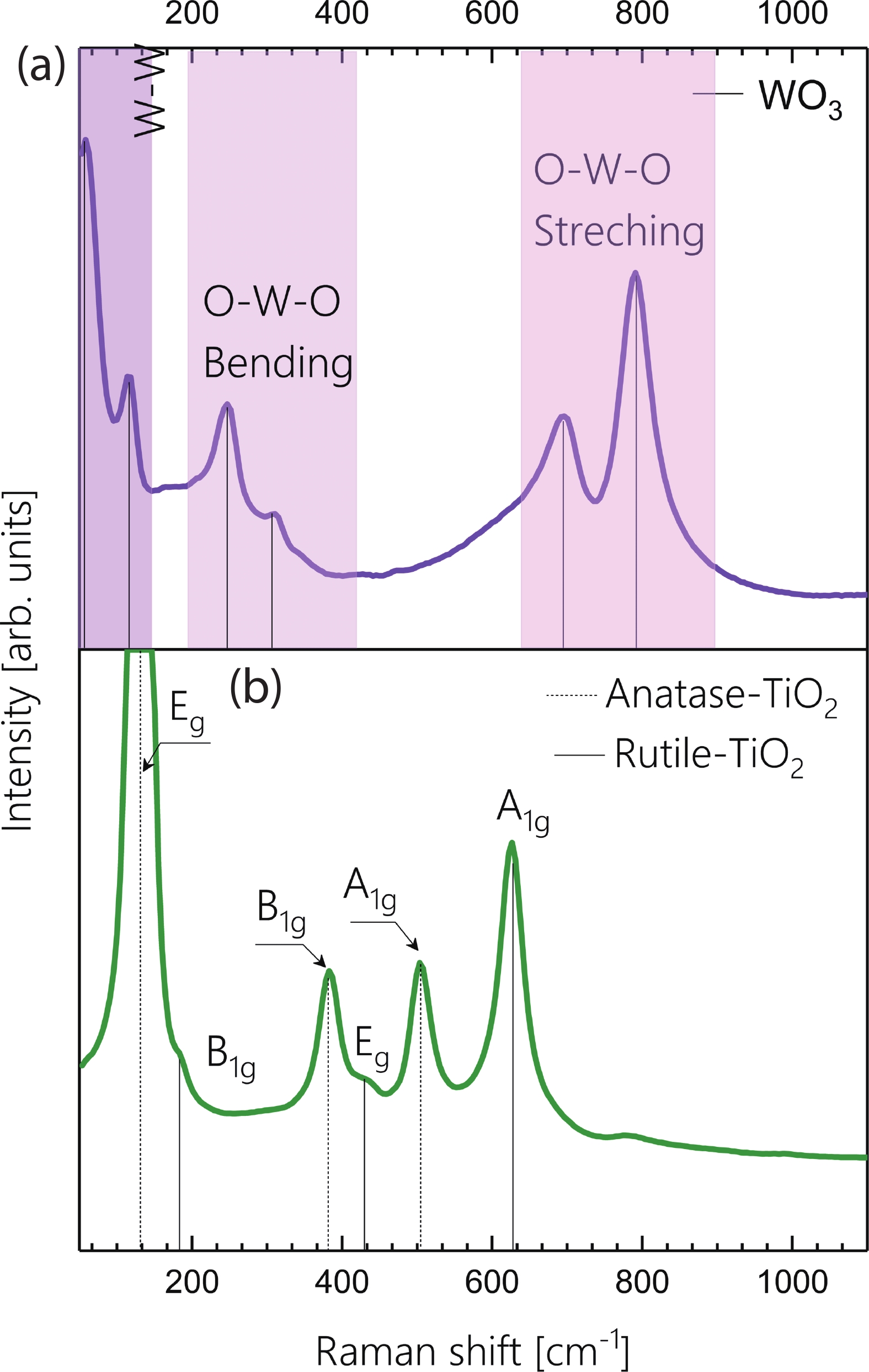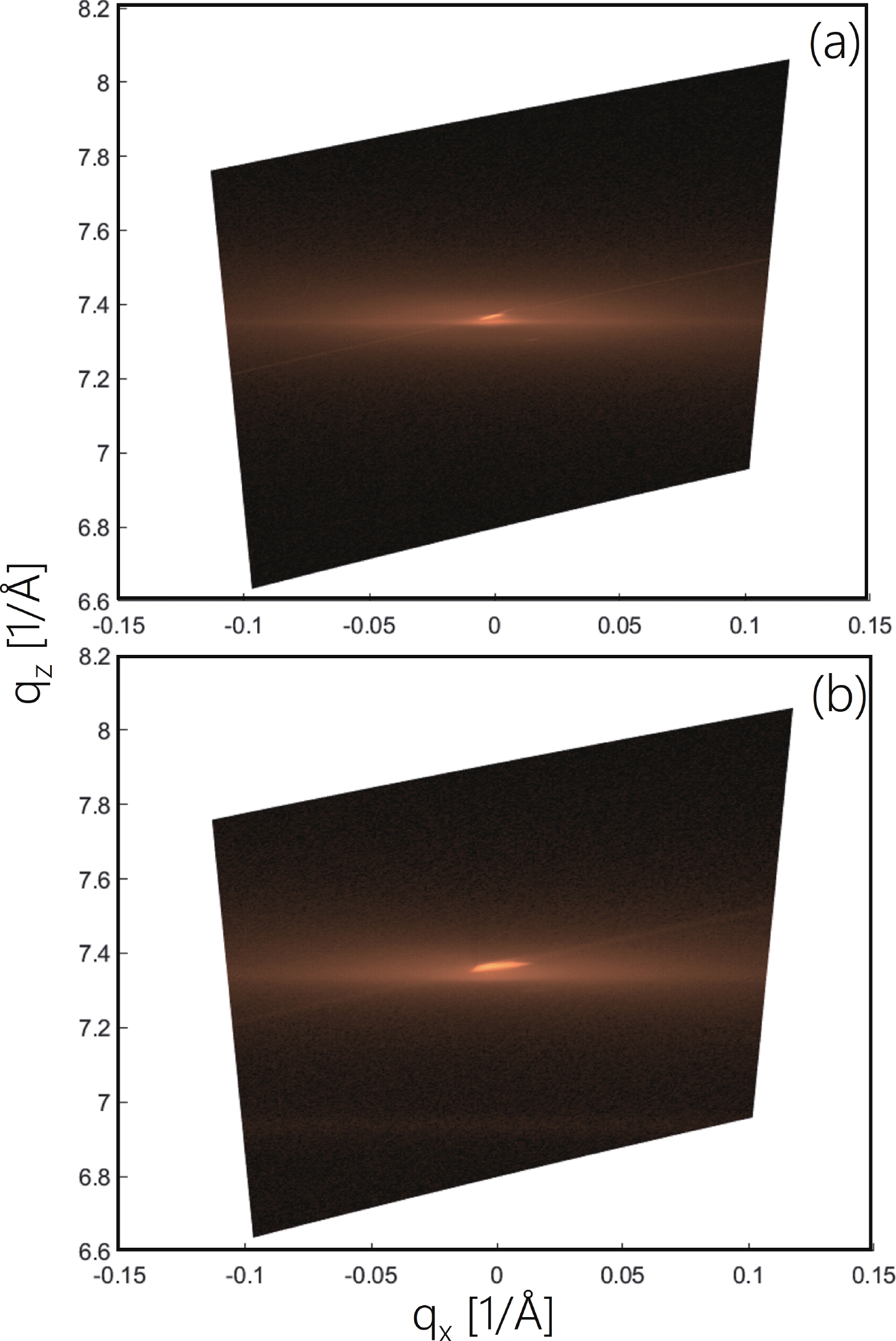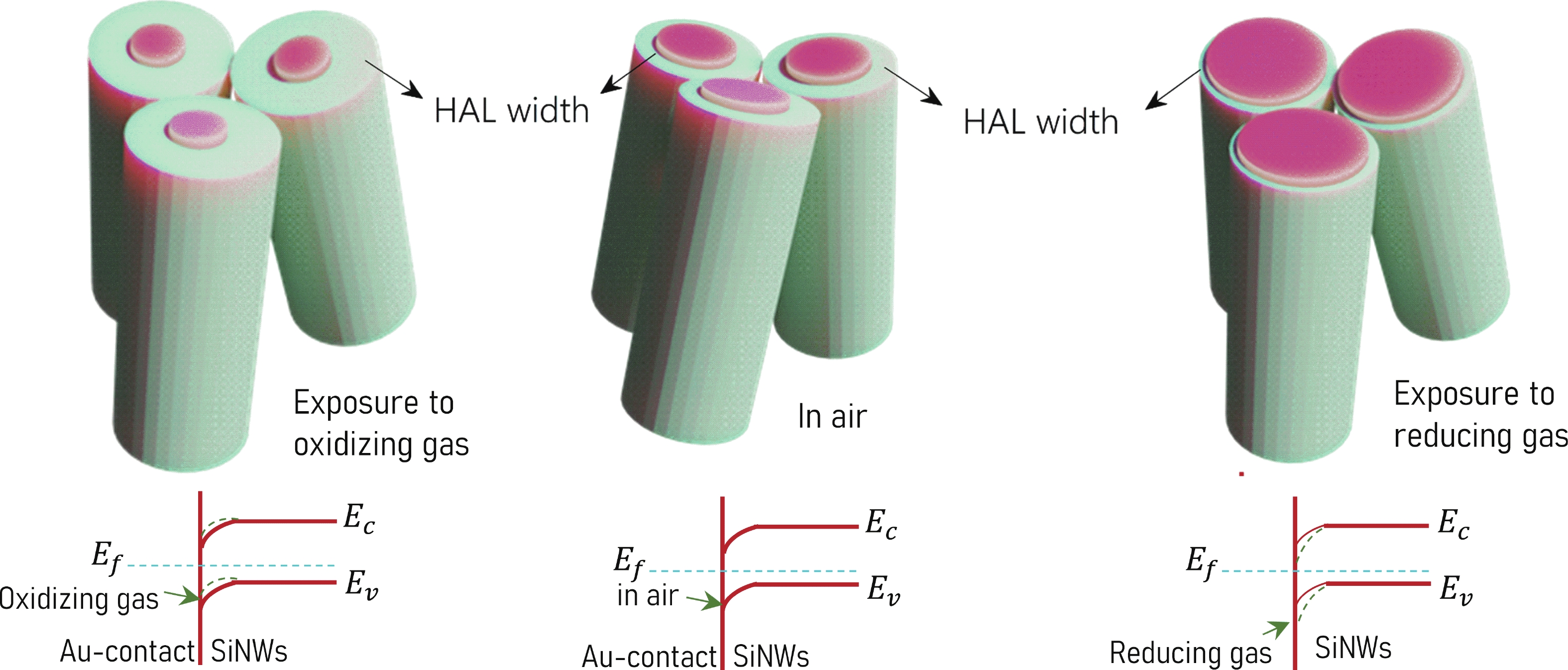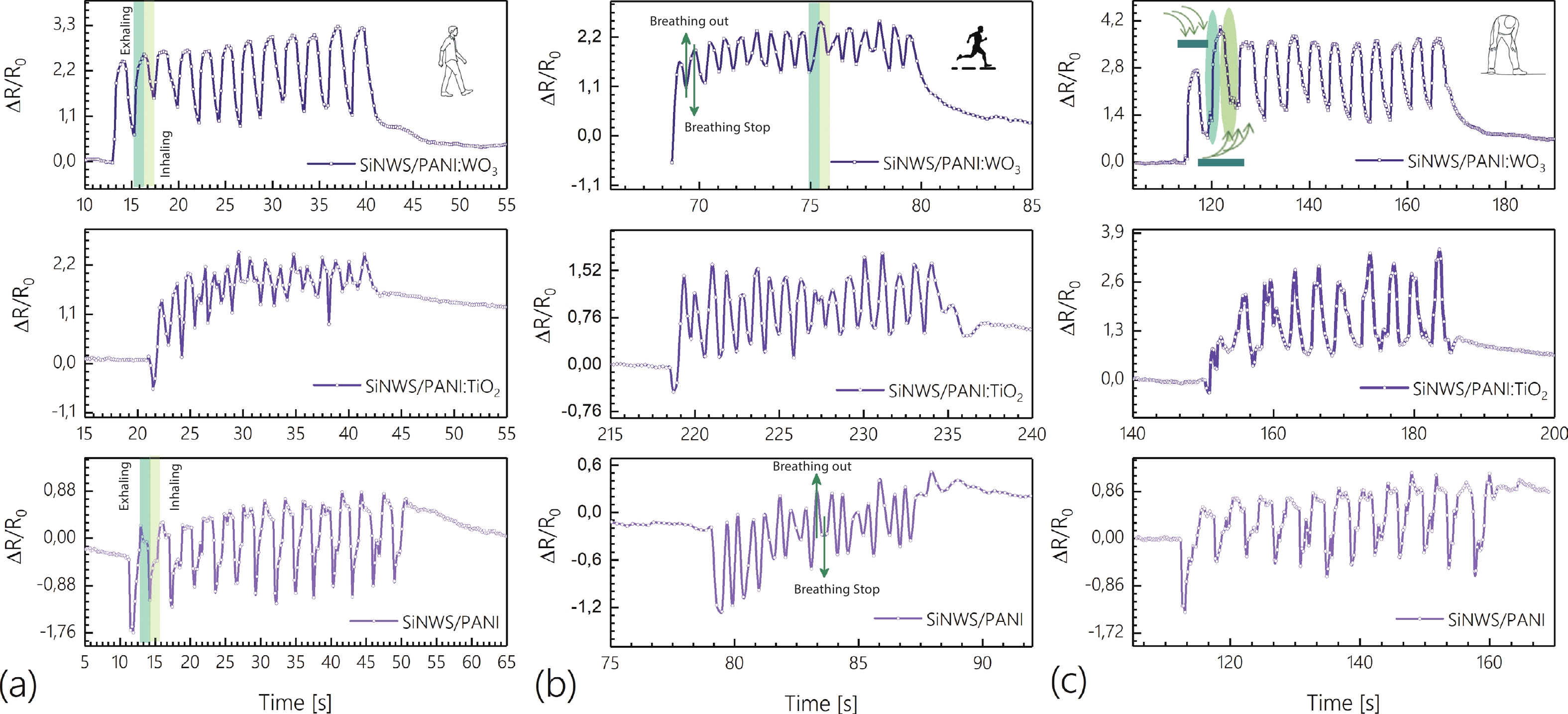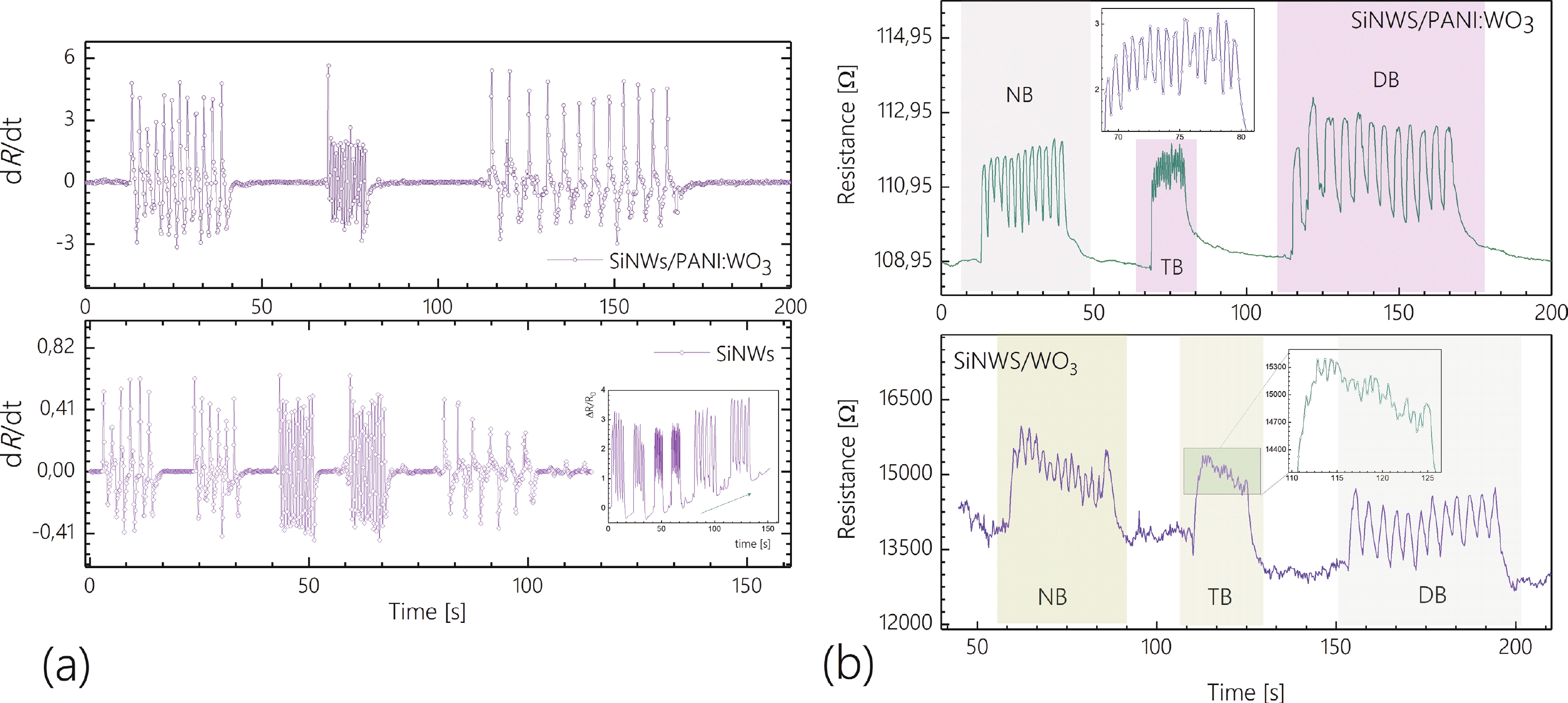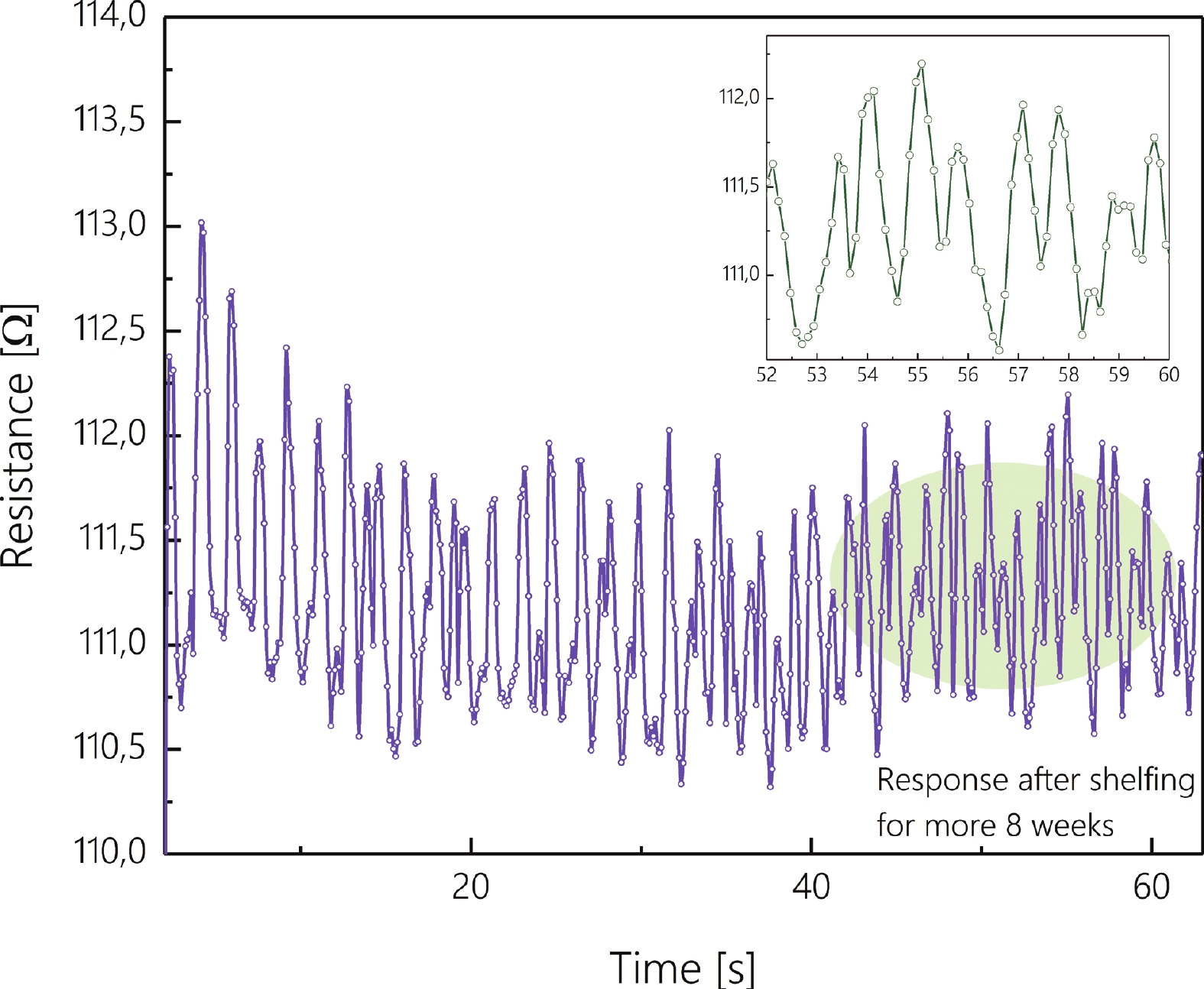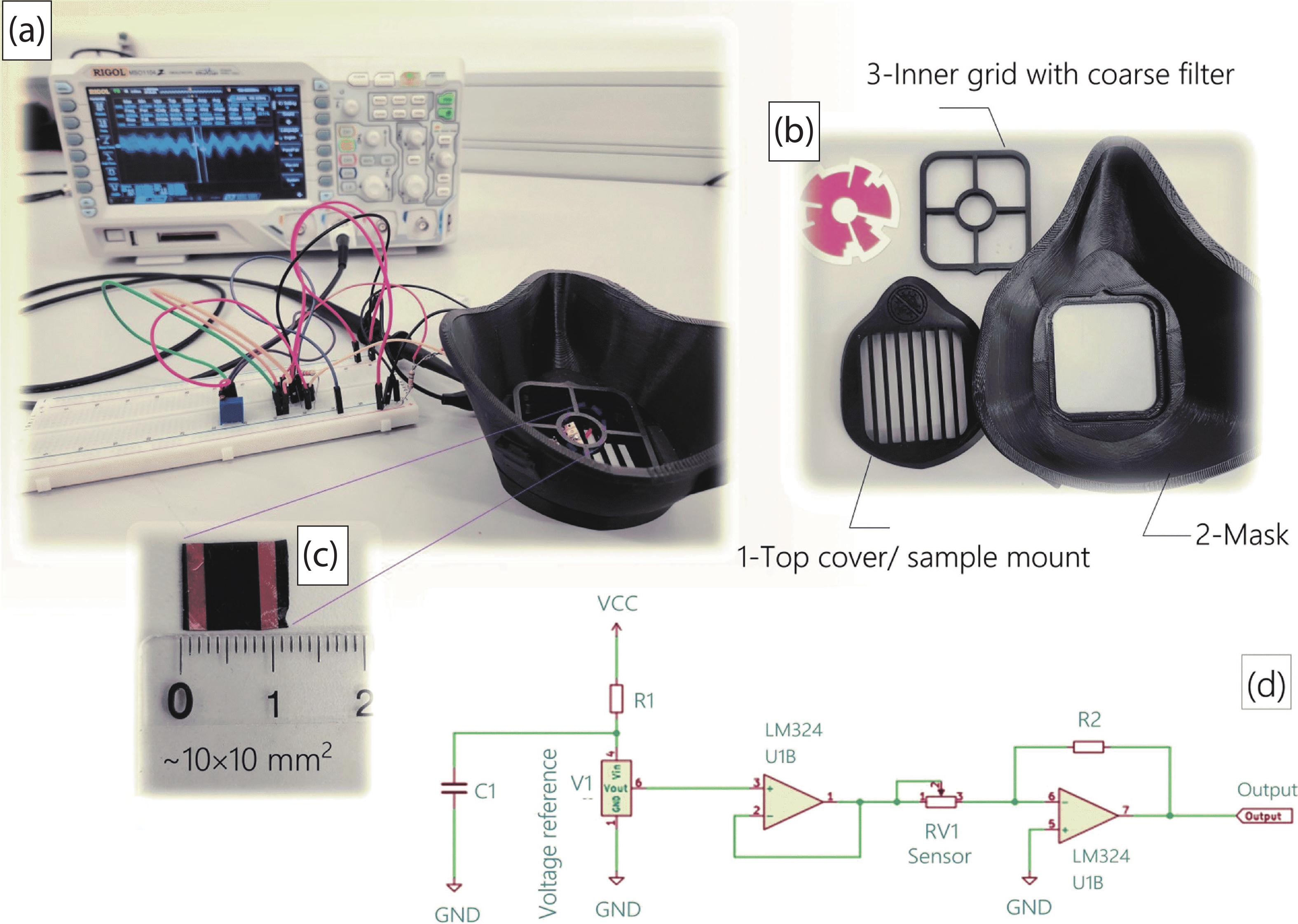| Citation: |
Muhammad Taha Sultan, Anca Dumitru, Elham Fakhri, Rachel Brophy, Snorri Thorgeir Ingvarsson, Andrei Manolescu, Halldor Gudfinur Svavarsson. Fabrication and application of SiNWs based PANI:MOx heterostructures for human respiratory monitoring[J]. Journal of Semiconductors, 2025, 46(3): 032101. doi: 10.1088/1674-4926/24090035
****
M T Sultan, A Dumitru, E Fakhri, R Brophy, S T Ingvarsson, A Manolescu, and H G Svavarsson, Fabrication and application of SiNWs based PANI:MOx heterostructures for human respiratory monitoring[J]. J. Semicond., 2025, 46(3), 032101 doi: 10.1088/1674-4926/24090035
|
Fabrication and application of SiNWs based PANI:MOx heterostructures for human respiratory monitoring
DOI: 10.1088/1674-4926/24090035
CSTR: 32376.14.1674-4926.24090035
More Information-
Abstract
In this study, we investigate an innovative hybrid structure of silicon nanowires (SiNWs) coated with polyaniline (PANI):metal oxide (MOx) nanoparticles, i.e., WO3 and TiO2, for respiratory sensing. To date, few attempts have been made to utilize such hybrid structures for that application. The SiNWs were fabricated using metal-assisted chemical etching (MACE), whereas PANI:MOx was deposited using chemical oxidative polymerization. The structures were characterized using Raman spectroscopy, X-ray diffraction, and scanning electron microscopy. The sensing characteristics revealed that the hybrid sensor exhibited a considerably better response than pure SiNWs:MOx and SiNWs:PANI. Such an enhancement in sensitivity is attributed to the formation of a p−n heterojunction between PANI and MOx, the wider conduction channel provided by PANI, increased porosity in SiNWs/PANI:WO3 hybrid structures, which creates active sites, increased oxygen vacancies, and the large surface area compared to that available in pure MOx nanoparticles. Furthermore, less baseline drift and increased sensor stability were established for the SiNWs structure coated with PANI:WO3, as compared to PANI:TiO2.-
Keywords:
- SiNWs,
- metal oxides,
- sensor,
- XRD,
- Raman spectroscopy,
- scanning electron micrscopy
-
References
[1] Akbari-Saatlu M, Procek M, Mattsson C, et al. Silicon nanowires for gas sensing: A review. Nanomaterials, 2020, 10, 2215 doi: 10.3390/nano10112215[2] Yu S G, Zhang H Y, Zhang J, et al. High-sensitivity RGO-TiO2 humidity sensor driven by triboelectric nanogenerators for non-contact monitoring of human respiration. J Alloys Compd, 2023, 935, 168006 doi: 10.1016/j.jallcom.2022.168006[3] Andreozzi E, Centracchio J, Punzo V, et al. Respiration monitoring via forcecardiography sensors. Sensors, 2021, 21, 3996 doi: 10.3390/s21123996[4] Mansour E, Vishinkin R, Rihet S, et al. Measurement of temperature and relative humidity in exhaled breath. Sens Actuat B Chem, 2020, 304, 127371 doi: 10.1016/j.snb.2019.127371[5] Wang C X, Yin L W, Zhang L Y, et al. Metal oxide gas sensors: Sensitivity and influencing factors. Sensors, 2010, 10, 2088 doi: 10.3390/s100302088[6] Liu X, Cheng S, Liu H, et al. A survey on gas sensing technology. Sensors (Basel), 2012, 12, 9635 doi: 10.3390/s120709635[7] Panigrahi P K, Chandu B, Puvvada N. Recent advances in nanostructured materials for application as gas sensors. ACS Omega, 2024, 9, 3092 doi: 10.1021/acsomega.3c06533[8] Guo S Y, Hou P X, Zhang F, et al. Gas sensors based on single-wall carbon nanotubes. Molecules, 2022, 27, 5381 doi: 10.3390/molecules27175381[9] Kong Y L, Li Y X, Cui X X, et al. SnO2 nanostructured materials used as gas sensors for the detection of hazardous and flammable gases: A review. Nano Mater Sci, 2022, 4, 339 doi: 10.1016/j.nanoms.2021.05.006[10] Sun Y F, Liu S B, Meng F L, et al. Metal oxide nanostructures and their gas sensing properties: A review. Sensors, 2012, 12, 2610 doi: 10.3390/s120302610[11] Ji F X, Ren X P, Zheng X Y, et al. 2D-MoO3 nanosheets for superior gas sensors. Nanoscale, 2016, 8, 8696 doi: 10.1039/C6NR00880A[12] Umar A, Alshahrani A A, Algarni H, et al. CuO nanosheets as potential scaffolds for gas sensing applications. Sens Actuat B Chem, 2017, 250, 24 doi: 10.1016/j.snb.2017.04.062[13] Comini E. Metal oxides nanowires chemical/gas sensors: Recent advances. Mater Today Adv, 2020, 7, 100099 doi: 10.1016/j.mtadv.2020.100099[14] Fakhri E, Sultan M T, Manolescu A, et al. Application of p- and n-type silicon nanowires as human respiratory sensing device. Sensors, 2023, 23, 9901 doi: 10.3390/s23249901[15] Kale P, Sahoo M K. Removal of Ag remanence and improvement in structural attributes of silicon nanowires array via sintering. Sci Rep, 2021, 11, 24189 doi: 10.1038/s41598-021-03654-5[16] Huang Z P, Geyer N, Werner P, et al. Metal-assisted chemical etching of silicon: A review. Adv Mater, 2011, 23, 285 doi: 10.1002/adma.201001784[17] Fakhri E, Sultan M T, Manolescu A, et al. Synthesis and photoluminescence study of silicon nanowires obtained by metal assisted chemical etching. 2021 International Semiconductor Conference (CAS), 2021, 147 doi: 10.1109/CAS52836.2021.9604178[18] He W S, Zhao Y H, Xiong Y H. Bilayer polyaniline-WO3 thin-film sensors sensitive to NO2. ACS Omega, 2020, 5, 9744 doi: 10.1021/acsomega.9b04122[19] Masuda Y, Uozumi A. Highly responsive diabetes and asthma sensors with WO3 nanoneedle films for the detection of biogases with low concentrations. NPG Asia Mater, 2023, 15, 69 doi: 10.1038/s41427-023-00515-7[20] Kulkarni S B, Navale Y H, Navale S T, et al. Hybrid polyaniline-WO3 flexible sensor: A room temperature competence towards NH3 gas. Sens Actuat B Chem, 2019, 288, 279 doi: 10.1016/j.snb.2019.02.094[21] Bandgar D K, Navale S T, Naushad M, et al. Ultra-sensitive polyaniline–iron oxide nanocomposite room temperature flexible ammonia sensor. RSC Adv, 2015, 5, 68964 doi: 10.1039/C5RA11512D[22] Bonyani M, Zebarjad S M, Janghorban K, et al. Enhanced NO2 gas sensing properties of ZnO-PANI composite nanofibers. Ceram Int, 2023, 49, 1238 doi: 10.1016/j.ceramint.2022.09.103[23] Pippara R K, Chauhan P S, Yadav A, et al. Room temperature hydrogen sensing with polyaniline/SnO2/Pd nanocomposites. Micro Nano Eng, 2021, 12, 100086 doi: 10.1016/j.mne.2021.100086[24] Tian J F, Yang G, Jiang D G, et al. A hybrid material consisting of bulk-reduced TiO2, graphene oxide and polyaniline for resistance based sensing of gaseous ammonia at room temperature. Microchim Acta, 2016, 183, 2871 doi: 10.1007/s00604-016-1912-6[25] Kumar R, Yadav B C. Fabrication of polyaniline (PANI)—tungsten oxide (WO3) composite for humidity sensing application. J Inorg Organomet Polym Mater, 2016, 26, 1421 doi: 10.1007/s10904-016-0412-9[26] Mhamdi H, Zaghouani R B, Fiorido T, et al. Study of n-WO3/p-porous silicon structures for gas-sensing applications. J Mater Sci Mater Electron, 2020, 31, 7862 doi: 10.1007/s10854-020-03324-8[27] Chaudhary V, Kaur A. Enhanced room temperature sulfur dioxide sensing behaviour of in situ polymerized polyaniline–tungsten oxide nanocomposite possessing honeycomb morphology. RSC Adv, 2015, 5, 73535 doi: 10.1039/C5RA08275G[28] Wang Z H, Lan K B, Wang Z, et al. High-performance PANI sensor on silicon nanowire arrays for sub-ppb NH3 detection. Talanta, 2025, 282, 127086 doi: 10.1016/j.talanta.2024.127086[29] Jain A, Nabeel A N, Bhagwat S, et al. Fabrication of polypyrrole gas sensor for detection of NH3 using an oxidizing agent and pyrrole combinations: Studies and characterizations. Heliyon, 2023, 9, e17611 doi: 10.1016/j.heliyon.2023.e17611[30] Khuspe G D, Bandgar D K, Sen S, et al. Fussy nanofibrous network of polyaniline (PANi) for NH3 detection. Synth Met, 2012, 162, 1822 doi: 10.1016/j.synthmet.2012.08.022[31] Huang J, Yang T L, Kang Y F, et al. Gas sensing performance of polyaniline/ZnO organic-inorganic hybrids for detecting VOCs at low temperature. J Nat Gas Chem, 2011, 20, 515 doi: 10.1016/S1003-9953(10)60230-7[32] Fratoddi I, Venditti I, Cametti C, et al. Chemiresistive polyaniline-based gas sensors: A mini review. Sens Actuat B Chem, 2015, 220, 534 doi: 10.1016/j.snb.2015.05.107[33] Duong N H, Nguyen T T, Nguyen D T, et al. Effect of TiO2 on the gas sensing features of TiO2/PANi nanocomposites. Sensors, 2011, 11, 1924 doi: 10.3390/s110201924[34] Li S Q, Lin P F, Zhao L P, et al. The room temperature gas sensor based on Polyaniline@flower-like WO3 nanocomposites and flexible PET substrate for NH3 detection. Sens Actuat B Chem, 2017, 259, 505 doi: 10.1016/j.snb.2017.11.081[35] Lascu I, Locovei C, Bradu C, et al. Polyaniline-derived nitrogen-containing carbon nanostructures with different morphologies as anode modifier in microbial fuel cells. Int J Mol Sci, 2022, 23, 11230 doi: 10.3390/ijms231911230[36] Xu L J, Yin M L, Liu S F. Ag(x)@WO3 core-shell nanostructure for LSP enhanced chemical sensors. Sci Rep, 2014, 4, 6745 doi: 10.1038/srep06745[37] Challagulla S, Tarafder K, Ganesan R, et al. Structure sensitive photocatalytic reduction of nitroarenes over TiO2. Sci Rep, 2017, 7, 8783 doi: 10.1038/s41598-017-08599-2[38] Hardcastle F D. Raman spectroscopy of titania (TiO2) nanotubular water-splitting catalysts. Arkansas Academy Science, 2011, 65, 43 doi: 10.54119/jaas.2011.6504[39] Mousli F, Chaouchi A, Hocine S, et al. Diazonium-modified TiO2/polyaniline core/shell nanoparticles. Structural characterization, interfacial aspects and photocatalytic performances. Appl Surf Sci, 2019, 465, 1078 doi: 10.1016/j.apsusc.2018.09.252[40] Pakdel H, Galstyan V, D’Arco A, et al. Synthesis of WO3 nanopowder using a green surfactant for efficient gas sensing applications. Ceram Int, 2023, 49, 30501 doi: 10.1016/j.ceramint.2023.06.314[41] Aldrees A, Khan H, Alzahrani A, et al. Synthesis and characterization of tungsten trioxide (WO3) as photocatalyst against wastewater pollutants. Appl Water Sci, 2023, 13, 156 doi: 10.1007/s13201-023-01938-x[42] Ishida Y, Motono S, Doshin W, et al. Small nanosized oxygen-deficient tungsten oxide particles: Mechanistic investigation with controlled plasma generation in water for their preparation. ACS Omega, 2017, 2, 5104 doi: 10.1021/acsomega.7b00986[43] Fewster P. Reciprocal space mapping. Crit Rev Solid State Mater Sci, 1996, 22, 269 doi: 10.1080/10408439708241259[44] Stanchu H V, Kuchuk A V, Barchuk M, et al. Asymmetrical reciprocal space mapping using X-ray diffraction: A technique for structural characterization of GaN/AlN superlattices. Cryst Eng Comm, 2017, 19, 2977 doi: 10.1039/C7CE00584A[45] Tai H L, Wang S, Duan Z H, et al. Evolution of breath analysis based on humidity and gas sensors: Potential and challenges. Sens Actuat B Chem, 2020, 318, 128104 doi: 10.1016/j.snb.2020.128104[46] Ates H C, Dincer C. Wearable breath analysis. Nat Rev Bioeng, 2023, 1, 80 doi: 10.1038/s44222-022-00011-7[47] Fakhri E, Plugaru R, Sultan M T, et al. Piezoresistance characterization of silicon nanowires in uniaxial and isostatic pressure variation. Sensors, 2022, 22, 6340 doi: 10.3390/s22176340[48] Zhang S S, Lou L, Lee C K. Piezoresistive silicon nanowire based nanoelectromechanical system cantilever air flow sensor. Appl Phys Lett, 2012, 100, 023111 doi: 10.1063/1.3675878[49] Kim C, Ahn H, Ji T. Flexible pressure sensors based on silicon nanowire array built by metal-assisted chemical etching. IEEE Electron Device Lett, 2020, 41, 1233 doi: 10.1109/LED.2020.3001977[50] Ghosh R, Song M S, Park J, et al. Fabrication of piezoresistive Si nanorod-based pressure sensor arrays: A promising candidate for portable breath monitoring devices. Nano Energy, 2021, 80, 105537 doi: 10.1016/j.nanoen.2020.105537[51] Song Y H, Shu C, Song Z H, et al. Self-powered health monitoring with ultrafast response and recovery enabled by nanostructured silicon moisture-electric generator. Chem Eng J, 2023, 468, 143797 doi: 10.1016/j.cej.2023.143797[52] Qin Y X, Jiang Y Q, Zhao L M. Modulation of agglomeration of vertical porous silicon nanowires and the effect on gas-sensing response. Adv Eng Mater, 2018, 20, 1700893 doi: 10.1002/adem.201700893[53] Morganti D, Leonardi A A, Lo Faro M J, et al. Ultrathin silicon nanowires for optical and electrical nitrogen dioxide detection. Nanomaterials, 2021, 11, 1767 doi: 10.3390/nano11071767[54] Park S B, Khattar D. Tachypnea. Emerg Office Pediatr, 2024, 8, 33[55] Lou C G, Hou K X, Zhu W T, et al. Human respiratory monitoring based on Schottky resistance humidity sensors. Materials, 2020, 13, 430 doi: 10.3390/ma13020430[56] Kundu S, Majumder R, Ghosh R, et al. Relative humidity sensing properties of doped polyaniline-encased multiwall carbon nanotubes: Wearable and flexible human respiration monitoring application. J Mater Sci, 2020, 55, 3884 doi: 10.1007/s10853-019-04276-z[57] Ekande O S, Kumar M. Review on polyaniline as reductive photocatalyst for the construction of the visible light active heterojunction for the generation of reactive oxygen species. J Environ Chem Eng, 2021, 9, 105725 doi: 10.1016/j.jece.2021.105725[58] Xie H, Li N, Chen X Z, et al. Surface oxygen vacancies promoted photodegradation of benzene on TiO2 film. Appl Surf Sci, 2020, 511, 145597 doi: 10.1016/j.apsusc.2020.145597[59] Chen H, Liu Y, Xie C S, et al. A comparative study on UV light activated porous TiO2 and ZnO film sensors for gas sensing at room temperature. Ceram Int, 2012, 38, 503 doi: 10.1016/j.ceramint.2011.07.035[60] Rahman K H, Kar A K. Effect of band gap variation and sensitization process of polyaniline (PANI)-TiO2 p−n heterojunction photocatalysts on the enhancement of photocatalytic degradation of toxic methylene blue with UV irradiation. J Environ Chem Eng, 2020, 8, 104181 doi: 10.1016/j.jece.2020.104181[61] Nunes D, Fortunato E, Martins R. Flexible nanostructured TiO2-based gas and UV sensors: A review. Discov Mater, 2022, 2, 2 doi: 10.1007/s43939-022-00023-5[62] Liu D, Lin L M, Chen Q F, et al. Low power consumption gas sensor created from silicon nanowires/TiO2 core–shell heterojunctions. ACS Sens, 2017, 2, 1491 doi: 10.1021/acssensors.7b00459[63] Qin Y X, Wang Z F, Liu D, et al. Dendritic composite array of silicon nanowires/WO3 nanowires for sensitive detection of NO2 at room temperature. Mater Lett, 2017, 207, 29 doi: 10.1016/j.matlet.2017.07.042[64] Staerz A, Weimar U, Barsan N. Understanding the potential of WO3 based sensors for breath analysis. Sensors, 2016, 16, 1815 doi: 10.3390/s16111815[65] Kim S J, Choi S J, Jang J S, et al. Mesoporous WO3 nanofibers with protein-templated nanoscale catalysts for detection of trace biomarkers in exhaled breath. ACS Nano, 2016, 10, 5891 doi: 10.1021/acsnano.6b01196[66] Xu M T, Wang Y J, Chen F C, et al. Breathable Nanomesh pressure sensor with layered polyaniline grown at gas-liquid interface. Chem Eng J, 2022, 445, 136717 doi: 10.1016/j.cej.2022.136717[67] Wang X W, Zhang D Z, Zhang H B, et al. In situ polymerized polyaniline/MXene (V2C) as building blocks of supercapacitor and ammonia sensor self-powered by electromagnetic-triboelectric hybrid generator. Nano Energy, 2021, 88, 106242 doi: 10.1016/j.nanoen.2021.106242[68] Beygisangchin M, Hossein Baghdadi A, Kartom Kamarudin S, et al. Recent progress in polyaniline and its composites; Synthesis, properties, and applications. Eur Polym J, 2024, 210, 112948 doi: 10.1016/j.eurpolymj.2024.112948[69] Han B, Popov A L, Shekunova T O, et al. Highly crystalline WO3 nanoparticles are nontoxic to stem cells and cancer cells. J Nanomater, 2019, 5384132 doi: 10.1155/2019/5384132 -
Supplements
 24090035Supporting_information.pdf
24090035Supporting_information.pdf

-
Proportional views





 Muhammad Taha Sultan is a research specialist at Reykjavik Univeristy. He received his MSc. in Materials Science from CAU University Kiel, Germany and Ph.D. in Applied Physics in 2019 from Reykjavik University, Iceland. His research interest is in field of thin-films and nanotechnology along with their application in devices such as sensor, photovoltaics, photodetectors, magnetism and smart windows.
Muhammad Taha Sultan is a research specialist at Reykjavik Univeristy. He received his MSc. in Materials Science from CAU University Kiel, Germany and Ph.D. in Applied Physics in 2019 from Reykjavik University, Iceland. His research interest is in field of thin-films and nanotechnology along with their application in devices such as sensor, photovoltaics, photodetectors, magnetism and smart windows. Halldor Gudfinur Svavarsson Halldor Gudfinnur Svavarsson is a professor at Reykjavik University. He has a B.Sc. degree in chemistry from University of Iceland and an M.Sc. degree in mat. Science Eng. from the Technological University of Tampere, Finland. In 2003, he graduated with a Ph.D. degree in physics from the University of Iceland. His main research interest is in the field of silicon nano-nanostructures for sensing applications.
Halldor Gudfinur Svavarsson Halldor Gudfinnur Svavarsson is a professor at Reykjavik University. He has a B.Sc. degree in chemistry from University of Iceland and an M.Sc. degree in mat. Science Eng. from the Technological University of Tampere, Finland. In 2003, he graduated with a Ph.D. degree in physics from the University of Iceland. His main research interest is in the field of silicon nano-nanostructures for sensing applications.
 DownLoad:
DownLoad:
